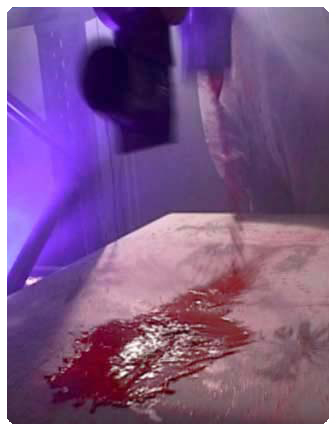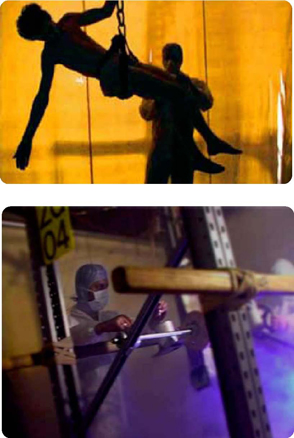

For the 2003 Zurich Dada Festival at the Sihlpapierfabrik, a large disused paper factory, London-based art group Luna Nera created "Pain[ting] Machine" - a live art installation engaging with ideas generated by the early Dada group in Zurich.
It was not a requirement of the Festival to make work which directly engaged with the DADA movement, but Luna Nera took this as their own brief. In homage to this prototype art group, "Pain[ting] Machine"was a live art work based on ideas developed by Tristan Tzara and Raymond Roussel. The machine was used for a live performance and then remained as a working installation in the Sihlpapierfabrik
The "Pain[ting] Machine" explores Tzara's idea of the human machine. Using found / waste materials sourced mainly from the factory: the group created a large machine that takes blood from a person (simulated) and pumps it into a machine which them “paints” onto prepared canvases. The "blood source" was one artist, who was hanging from a hook in the middle of the former factory floor. The hook was on a rail and the man was brought out into the main installation space by the rest of the artists, who were wearing white suits and surgical masks. The paintings were done onto large canvases which were prepared with photo-transfer images of the factory.


After the painting performance, the paintings were brought out and displayed in the room. The original intention was to sell or give away the paintings, but in this case they were left as part of the installation. The machine as it remained, with the “blood” in IV drip bottles, can also be operated by the public, who can use it to make their own art work.
The "painting machine" is also influenced by the idea of Raymond Roussel in 1912 & never built. Roussel's painting machine stayed a concept/vision of the artist being replaced by machines. What Roussel foresaw was our present state of existence where commercial patterns are being “invented” by machines, computers create mind boggling patterns and pets are robots.
The paint machine Luna Nera built reflected this state of spiritual bankruptcy, where the artist is entangled like a puppet in strings, to produce in order to please. At the same time, the paint machine not only represents the artist, but all humans as part of a greater machine, producing in order to exist and vice versa - existing in order to produce. Although Roussel never made the painting machine, Swiss artist Jean Tinguely used Roussel's plans to build a series of painting machines. Luna Nera took the ideas of all of these artists, freely mixing them in with their own macabre sensibility.
pain(ting) machine | Dadafest Zurich from GILLIAN MCIVER on Vimeo.
"Pain[ting] Machine" was an example of collaborative process. The idea was first conceived by Julian Ronnefeldt of the group who had been reading Roussel in preparation for participation in the Dada Festival.
Gillian McIver was at the same time reading Tzara, and all the group had been influenced by the Dada very early on. According to group member Valentina Floris, "It was when I found out about Dada that I began to think about being an artist."
Taking Ronnefeldt's basic sketches together with some medical supplies (IV bottles, syringes etc.) donated by a friend, along with some sound work created by Ben Foot, to Zurich, the group worked together to source raw materials from the site.
The site of the Sihlpapierfabrik is huge, with many buildings and a great deal of waste paper, lumber, metal odds and ends and so on. Foot and Ronnefeldt worked out the technical system to make the machine work with the materials that were found, and the group built it according to those plans. The group trusted Foot and Ronnefeldt’s technical abilities and were able to take directions from them. The aesthetic conceptualisation of the project, however, was very much a group endeavour.
Tot he Luna Nera group, the "Pain[ting] Machine" is site-responsive in that its realisation was very much site and context-dependent. The spirit and milieu of the Dada festival, and the environment and materials specific to the Sihlpapierfabrik, created the work as much as the artists. The project could be remade using the same concept but would necessarily change and mutate in this case.
2004